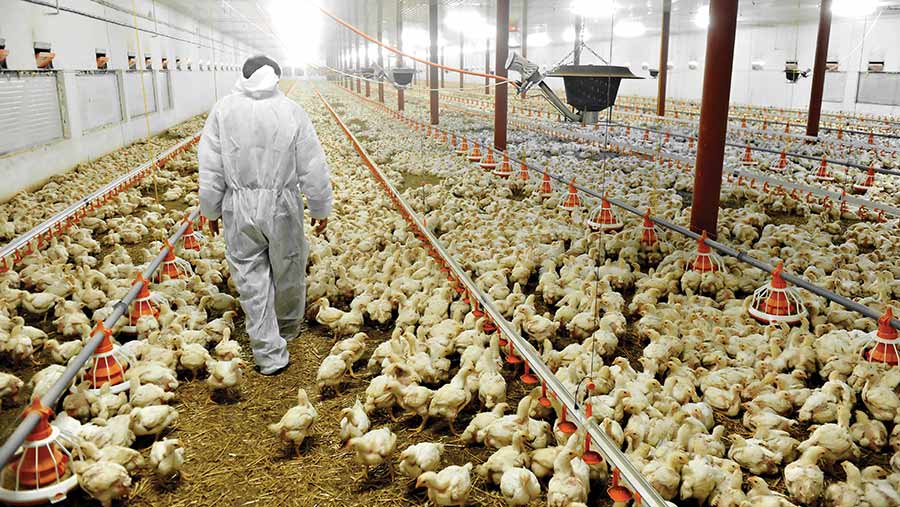Farm Doctor: How to protect yourself from farmer’s lung
 © SciePro/AdobeStock
© SciePro/AdobeStock Farmers are at risk of developing respiratory problems because of working in environments such as grain stores and poultry sheds where dust and spores in the air are prevalent.
Camilla Baker, farmer’s daughter and qualified doctor, explains a condition known as “farmer’s lung” and how to make sure you reduce your risk of developing the illness.
See also: Farm Doctor: Breaking down barriers to men’s health

Camilla Baker © Supplied by Camilla Baker
What is farmer’s lung?
“Farmer’s lung is a breathing condition that can affect people who are exposed to the dust and mould spores that grow on hay, straw and grain,” Camilla explains.
“The medical term for this condition is hypersensitivity pneumonitis.
“It occurs when the lungs develop an immune response – hypersensitivity – to something that you breathe in, which results in irritation and inflammation of the lung tissue, known as pneumonitis.
“This condition can also occur in people who are exposed to particles in bird droppings or feathers.”
Inhaling these spores does not lead to infection, but rather causes an allergic reaction and irritation in the small air sacs in the lungs.
“These trigger particles are called allergens,” explains Camilla.
“You may develop symptoms after a sudden, large exposure (acute farmer’s lung) or after lots of smaller exposures (leading to chronic farmer’s lung).
“When someone has ongoing exposure, the irritation continues. This can, in turn, lead to scarring of the lungs – known as pulmonary fibrosis.
“When this scarring builds up, it can make breathing increasingly difficult.”

© Roibu/Adobe Stock
Prevention
Thankfully, only a small number of people who inhale these dusts and mould spores will develop farmer’s lung, and evidence suggests that it is becoming a much rarer condition.
“This is likely due to preventative measures” says Camilla.
As with many health conditions, prevention is key, and the most important part of managing or preventing farmer’s lung is to reduce exposure to trigger particles.
“For farmers, this will mean drying crops adequately before storage and ensuring good ventilation.
“Respiratory protection should also be worn by farmers and farmworkers when handling stored crops, particularly if they have been stored damp or are likely to be mouldy.
“Advice around ventilation and respiratory protection is equally important for people working with birds,” says Camilla.
Symptoms
There is no “one size fits all” when it comes to identifying signs and symptoms of farmer’s lung.
“The reaction can be a sudden attack or symptoms can develop slowly over time,” Camilla explains. “People do not generally associate their breathing problems with working or their working environment.
“In a sudden attack, after a large exposure to trigger particles, symptoms may appear after four to six hours. These symptoms include a dry cough, shortness of breath, chest tightness, and – more rarely – fever and chills.
“The symptoms quickly resolve, usually within days.”
However, where there has been repeated exposure to the trigger particles and the inflammation has caused scarring, attacks can be more serious, leading to chronic farmer’s lung.
“The symptoms include increasing shortness of breath when moving around and an ongoing dry cough.
“With chronic lung conditions, you may also notice a change in your fingertips, which may appear swollen or rounded – and the nail may change shape, called clubbing.
“These symptoms appear gradually, over a long period of time,” says Camilla.
Diagnosis and treatment
A GP will generally diagnose farmer’s lung by asking questions about symptoms and occupational history.
“They will also listen to your lungs with a stethoscope and may order different tests to look at how well your lungs are working, and to see if there is evidence of scarring,” says Camilla.
“Sometimes, if there is a history of exposure to trigger particles, your doctor may order a blood test.”
Treatment for farmer’s lung will be based on its severity, but usually focuses on managing symptoms, or slowing down the scarring process.
However, Camilla explains that once scarring has occurred, it cannot be reversed.
“Supportive treatments such as oxygen therapy and pulmonary rehabilitation may be offered in this instance.
“Shortness of breath and breathing difficulties can be a frightening experience and greatly impacts a person’s everyday life.
“Pulmonary rehabilitation is designed to support and reassure you, as well as help with your condition.”
Get advice on farmer’s lung
Leading charity Asthma + Lung UK urges anyone who thinks they may be affected by farmer’s lung to visit their GP.
Emma Rubach, head of health advice, said: “Luckily with swift diagnosis, it is something that can be treated – and as long as the cause is identified and avoided, a full recovery is likely.
“Treatments are easily available and may include steroids over the course of a few weeks or months to help ease the inflammation.”
When seeing your doctor, make sure to discuss your occupation and potential exposure to dust, mould and birds.
Further advice is available on the charity’s helpline 0300 222 5800, or visit asthmaandlung.org.uk
